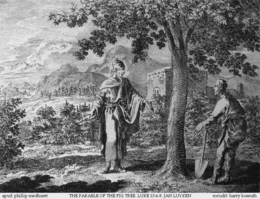Parable of the barren fig tree: Difference between revisions
→Narrative: use public domain translation |
Please wait till debate is resolved |
||
| Line 8: | Line 8: | ||
The parable is as follows: |
The parable is as follows: |
||
{{quotation| |
{{quotation|And he told this parable: "A man had a fig tree planted in his vineyard, and he came seeking fruit on it and found none. And he said to the vinedresser, 'Look, for three years now I have come seeking fruit on this fig tree, and I find none. Cut it down. Why should it use up the ground?' And he answered him, 'Sir, let it alone this year also, until I dig around it and put on manure. Then if it should bear fruit next year, well and good; but if not, you can cut it down.'"|Luke 13:6–9, [[English Standard Version]]}} |
||
==Interpretation== |
==Interpretation== |
||
Revision as of 20:52, 25 September 2010

The Parable of the Barren Fig Tree is a parable told by Jesus in the New Testament, and found in Luke Luke 13:6–9. The parable involves a fig tree, as does the equally brief parable of the budding fig tree, with which it should not be confused.
Narrative

The parable is as follows:
And he told this parable: "A man had a fig tree planted in his vineyard, and he came seeking fruit on it and found none. And he said to the vinedresser, 'Look, for three years now I have come seeking fruit on this fig tree, and I find none. Cut it down. Why should it use up the ground?' And he answered him, 'Sir, let it alone this year also, until I dig around it and put on manure. Then if it should bear fruit next year, well and good; but if not, you can cut it down.'"
— Luke 13:6–9, English Standard Version
Interpretation
In this parable, the owner is generally regarded as representing God, and the gardener (vinedresser) Jesus.[1] Fig trees were often planted in vineyards.[2]
The fig tree was a common symbol for Israel, and may also have that meaning here,[1] or the tree in the parable may refer to the religious leadership.[2] In either case, the parable reflects Jesus offering his hearers one last chance for repentance.[2] The limited time period mentioned provides an "eschatological urgency".[2]
The parable has been connected to the miracle of cursing the fig tree. Richard Whately commented that this parable "is one which our Lord may be said to have put before his hearers twice; once in words, once in action."[3]
Authenticity
Although the parable is found only in Luke's gospel, there is no strong argument against authenticity, and the majority of the members of the Jesus Seminar voted it authentic.[2]
See also
References
- ^ a b Timothy Maurice Pianzin, Parables of Jesus: In the Light of Its Historical, Geographical & Socio-Cultural Setting, Tate Publishing, 2008, ISBN 1602479232, pp. 235-237.
- ^ a b c d e Peter Rhea Jones, Studying the Parables of Jesus, Smyth & Helwys, 1999, ISBN 1573121673, pp. 123-133.
- ^ Richard Whately, Lectures on Some of the Scripture Parables, John W. Parker and Son, 1859, p. 153.
